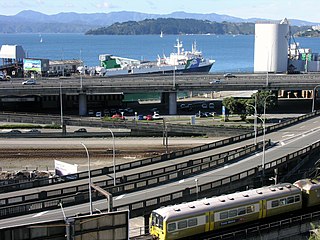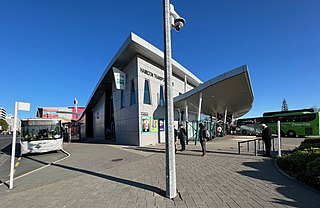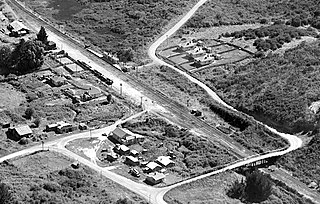Related Research Articles

Transport in New Zealand, with its mountainous topography and a relatively small population mostly located near its long coastline, has always faced many challenges. Before Europeans arrived, Māori either walked or used watercraft on rivers or along the coasts. Later on, European shipping and railways revolutionised the way of transporting goods and people, before being themselves overtaken by road and air, which are nowadays the dominant forms of transport. However, bulk freight still continues to be transported by coastal shipping and by rail transport, and there are attempts to (re)introduce public transport as a major transport mode in the larger population centres.

Lindis Pass is located in the South Island of New Zealand. A carpark at the top of the pass provides access to a viewpoint and two short trails to other viewing spots.

Milton, formerly known as Tokomairiro or Tokomairaro, is a town of over 2,000 people, located on State Highway 1, 50 kilometres to the south of Dunedin in Otago, New Zealand. It lies on the floodplain of the Tokomairaro River, one branch of which loops past the north and south ends of the town. This river gives its name to many local features, notably the town's only secondary school, Tokomairiro High School.
The Te Manatū WakaMinistry of Transport is the public service department of New Zealand charged with advising the government on transport policy. The Ministry works closely with other government transport partners, including the New Zealand Transport Agency (NZTA) to advance their strategic objectives.
In New Zealand, vehicle registration plates contain up to six alphanumeric characters, depending on the type of vehicle and the date of registration. To be operated on any public road, most types of motor vehicles and trailers must be registered and display the corresponding registration plate(s). One plate must be affixed to the rear of the vehicle, and except in the case of a motorcycle, moped, tractor, or trailer, a second plate must be affixed to the front of the vehicle.

State Highway 2 runs north–south through eastern parts of the North Island of New Zealand from the outskirts of Auckland to Wellington. It runs through Tauranga, Gisborne, Napier, Hastings and Masterton. It is the second-longest highway in the North Island, after State Highway 1, which runs the length of both of the country's main islands.
The New Zealand driver licence system is a graduated system that has been in place since 1988. It consists of three phases for a car licence, each with varying levels of conditions.
State Highway 21 (SH 21) is a short 6.7 kilometre stretch of highway in the North Island of New Zealand. It links State Highway 1, Waikato Expressway at Tamahere and State Highway 3 at Ōhaupō. Its main destination is Hamilton Airport and Mystery Creek, where the National Agricultural Fieldays are held.
Waka Kotahi NZ Transport Agency (NZTA), formally the New Zealand Transport Agency, is a New Zealand Crown entity tasked with promoting safe and functional transport by land, including the responsibility for driver and vehicle licensing, and administering the New Zealand state highway network.

Robert Gillies was a 19th-century Member of Parliament in Otago, New Zealand. He was born in Rothesay on the Isle of Bute, Scotland.
State Highway 39 (SH 39) is a New Zealand state highway that forms a western bypass of the city of Hamilton. Gazetted in 1999, it is a generally quicker route to get between Auckland and New Plymouth as well as connecting to the Waitomo Caves, just south of the SH 39 southern terminus. The southernmost 14 km section has a concurrency with SH 31, as this highway has existed for much longer.
State Highway 23 (SH 23) is a New Zealand state highway that connects the towns of Raglan and Hamilton.

State Highway 31 (SH 31) is a New Zealand state highway in the Waikato region. It provides a link to the harbour town of Kawhia on the west coast of the North Island.
State Highway 27 (SH 27) is a state highway in the Waikato region of the North Island of New Zealand. It is an important north–south link along the Waihou/Piako valley and forms an important transport route across the mostly dairy farming Matamata-Piako District. SH 27, in conjunction with SH 2, is often used as an alternative route to SH 1 between Auckland and Tauranga, Rotorua and Taupō.

Only 0.9% of transport in Hamilton and the Waikato Region was made by bus in 2013/14. This compares with 2.3% nationally, which itself is amongst the lowest modal shares in the world. A Mass Transit Plan aiming to increase public transport's share in Hamilton from 3 to 10% by running services at 10 minute intervals, was to be developed in 2019, but has yet to be funded by NZTA. Waikato, like all other regions, with the exception of Auckland and Wellington, saw falls in use of public transport from 2012. As the map shows, the coverage is sparse and, even of those services which operate daily, most have only 2 or 3 buses a day in each direction. Only Hamilton urban services and those to Huntly run hourly, or more frequently. About 40% of passengers travel on the two routes which run at 15 minute intervals. From Monday 21 February 2022 the less frequent Hamilton buses were cut to hourly, or 2-hourly, due to driver shortages.
Orini is a rural community in the Waikato District and Waikato region of New Zealand's North Island. It is located east of Taupiri

Kopaki was a flag station on the North Island Main Trunk line, in the Waitomo District of New Zealand.

Tararu is a former gold-mining village on the west coast of the Coromandel Peninsula of New Zealand. State Highway 25 runs through it; Te Puru being about 7 km (4.3 mi) to the north, and Thames about 2 km (1.2 mi) to the south.

The adoption of plug-in electric vehicles in New Zealand is supported by incentives and policies devised by the New Zealand Government. The monetary incentives include electric vehicle discounts, exemptions from road user charges, and electric vehicle sales targets. As of June 2023, there were 84,914 plug-in electric vehicles in New Zealand, consisting of 61,219 battery-electric vehicles and 23,695 plug-in hybrid vehicles. Plug-in electric vehicles make up 1.77% of New Zealand's 4,798,770 vehicle fleet.
References
- ↑ Agency, Waka Kotahi NZ Transport. "Road code – All updates". Waka Kotahi NZ Transport Agency. Retrieved 4 December 2021.
- ↑ "Free Road Code Practice | Driving Test". www.drivingtests.co.nz.
- ↑ "Visiting Drivers Project". NZ Transport Agency. Retrieved 6 August 2018.
- ↑ "First Labour Cabinet EVENING STAR". paperspast.natlib.govt.nz. 5 December 1935. Retrieved 27 October 2021.
- ↑ "ROAD SAFETY. OTAGO DAILY TIMES". paperspast.natlib.govt.nz. 4 December 1936. Retrieved 27 October 2021.
- ↑ "THE HIGHWAY CODE. OTAGO DAILY TIMES". paperspast.natlib.govt.nz. 4 December 1936. Retrieved 27 October 2021.
- ↑ "Search results for Highway Code + Belisha". paperspast.natlib.govt.nz. Retrieved 27 October 2021.